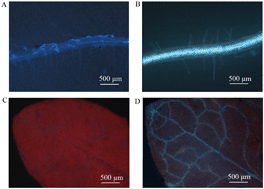Phenotypic, transcriptional, physiological and metabolic responses to carbon nanodot exposure in Arabidopsis thaliana (L.)†‡
Abstract
In this study, we systematically investigated the fate and phytotoxicity of carbon nanodots (C-dots, about 3 nm) in Arabidopsis thaliana (Arabidopsis), as well as the underlying potential mechanisms, by integrating transcriptomic, physiological and metabolomic techniques. The phytotoxicity of C-dots in Arabidopsis was concentration-dependent. C-dots at 125, 250, 500 and 1000 mg L−1 significantly reduced the root elongation by 25%, 40%, 56% and 61%, respectively, compared with the control groups, while no significant inhibition was observed in 62.5 mg L−1 C-dot exposure. RNA-seq analyses showed that 715 and 636 genes in Arabidopsis roots and shoots, respectively, were up-regulated by 1000 mg L−1 C-dots, which were involved in stimulus response, UDP-glycosyltransferase activity and cellular response to phosphate starvation. Meanwhile, 552 and 707 down-regulated genes in roots and shoots, respectively, were mainly involved in chloroplast structure and function. Furthermore, obvious physiological responses were found in plants exposed to 1000 mg L−1 C-dots, e.g., the activities of glutathione reductase significantly increased by 1.8 and 2.4 times in Arabidopsis roots and shoots in contrast to controls, respectively, while the activity of three photosynthesis enzymes (Rubisco, FBP and FDA) in Arabidopsis shoots was reduced by 38%, 22% and 34%, respectively. Based on gas chromatography-mass spectrometry, untargeted metabolomic analyses revealed that the contents of 13 and 22 metabolites were significantly changed in the root and shoots exposed to 1000 mg L−1 C-dots, respectively. In conclusion, the results of this study could provide insights into the molecular mechanisms of the phytotoxic effects of C-dots on plants.



 Please wait while we load your content...
Please wait while we load your content...